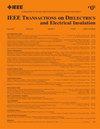Temperature Driven to Form In Situ Adaptive Graded Permittivity in Epoxy Vitrimers for Improving AC Surface Breakdown
IF 3.1
3区 工程技术
Q2 ENGINEERING, ELECTRICAL & ELECTRONIC
IEEE Transactions on Dielectrics and Electrical Insulation
Pub Date : 2025-01-15
DOI:10.1109/TDEI.2025.3530328
引用次数: 0
Abstract
Functionally permittivity-graded polymer composites are expected to be used as a solid dielectric for uniformizing the electric field near the metal electrode. In this article, epoxy vitrimers are employed to mitigate the electric field stress near the heating high-voltage (HV) electrode via a permittivity gradient induced in situ by a temperature gradient, thus enhancing the ac surface flashover voltages at high temperatures. Specifically, we uncover a dramatic acceleration in stress relaxation that arises from the topological rearrangement of the epoxy vitrimers, which causes a significant increase in the dielectric constant at high temperatures. The ac surface flashover voltages, dielectric constant, and electric field distribution of the epoxy vitrimers depending on temperature are studied. The epoxy vitrimers containing abundant温度驱动环氧树脂形成原位自适应梯度介电常数以改善交流表面击穿
功能介电常数梯度聚合物复合材料有望用作均匀化金属电极附近电场的固体介质。在这篇文章中,环氧树脂聚合物通过温度梯度在原位诱导的介电常数梯度来减轻加热高压(HV)电极附近的电场应力,从而提高高温下交流表面的闪络电压。具体来说,我们发现应力松弛的急剧加速是由环氧树脂聚合物的拓扑重排引起的,这导致高温下介电常数的显著增加。研究了环氧树脂的交流表面闪络电压、介电常数和电场随温度的分布。含有丰富的$\ β $ -羟基酯基的环氧树脂比填充陶瓷颗粒的聚合物表现出更强的介电常数温度特性,当高压电极温度从室温(RT)升高到$100~ $ {\circ}$ C时,表面闪络电压升高13.5%,比含有少量$\ β $ -羟基酯基的环氧树脂高26倍。“${V}_{{2}}$”受热高压电极附近的最大电场减小了46%,这是温度梯度下交流表面闪络增大的主要因素。本文的工作对环保型高分子绝缘材料在高压电气设备中的应用有一定的帮助。
本文章由计算机程序翻译,如有差异,请以英文原文为准。
求助全文
约1分钟内获得全文
求助全文
来源期刊
CiteScore
6.00
自引率
22.60%
发文量
309
审稿时长
5.2 months
期刊介绍:
Topics that are concerned with dielectric phenomena and measurements, with development and characterization of gaseous, vacuum, liquid and solid electrical insulating materials and systems; and with utilization of these materials in circuits and systems under condition of use.

 求助内容:
求助内容: 应助结果提醒方式:
应助结果提醒方式:


